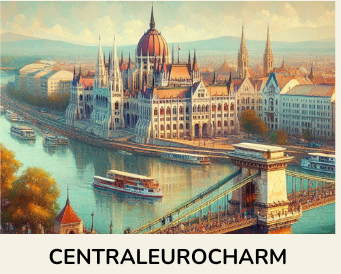Discover Budapest Through Its Architecture: A Journey Into Hungary’s Living History
Explore Budapest’s Stunning Architecture and Must-See Landmarks—from Buda Castle to Heroes’ Square
Budapest is more than just Hungary’s capital—it’s a living museum of architecture, where every building tells a story. From Gothic cathedrals and Neo-Renaissance palaces to Art Nouveau masterpieces, the city reflects Hungary’s cultural identity and historical resilience in stone, iron, and glass.
A City of Architectural Treasures
As you walk through the city, Budapest’s streets reveal a breathtaking blend of styles: Gothic spires, Neo-Renaissance façades, and the fluid elegance of Art Nouveau architecture. These styles aren’t just visually striking—they reflect Hungary’s long journey through empires, revolutions, and modern rebirth.
Budapest architecture is a visual expression of the nation’s identity—proud, artistic, and resilient. Each building is a time capsule, preserving the spirit of different eras and national aspirations.
The Royal Heart of Budapest: Buda Castle and Its Neighbors
Perched atop Castle Hill, Buda Castle overlooks the Danube as a symbol of Hungary’s strength. Originally built in the 13th century and rebuilt many times since, it now houses museums and offers panoramic views of the city. Walking through its courtyards feels like flipping through pages of Hungarian history.
Nearby, Fishermen’s Bastion enchants with its fairy-tale towers. Though built in the late 19th century, its design evokes medieval fortresses. It honors the fishermen who once defended this part of the city wall and offers one of the best vantage points for a Budapest skyline photo.
Don’t miss Gellért Hill and the Citadella, where natural beauty meets historical significance. The hill’s famous hot springs are the source of Budapest’s thermal bath culture, while the Citadella fortress now stands as a monument to freedom and resistance.
Bridges and Basilicas: Where Past Meets Present
Among Budapest’s most iconic landmarks, the Chain Bridge (Lánchíd) stands out. Completed in 1849, it was the first permanent bridge to unite Buda and Pest. This suspension bridge is more than infrastructure—it’s a symbol of national unity and modernization. Walking across it gives you a sense of Budapest’s grandeur and purpose.
St. Stephen’s Basilica, named after Hungary’s first king, is a neoclassical masterpiece and spiritual hub. Inside, you’ll find soaring ceilings, sacred relics, and incredible acoustics. Climb to the viewing platform for sweeping city views. Attend a classical concert here, and you’ll understand why Budapest is often called the Paris of the East.
Civic Pride in Stone: Parliament and Heroes’ Square
Hungary’s national identity is carved into its grand public spaces. The Hungarian Parliament Building, one of Europe’s most stunning legislative buildings, features Gothic Revival architecture, ornate interiors, and a riverfront presence that rivals London’s Westminster.
In Heroes’ Square, statues of Hungary’s founding tribes and national leaders stand in a monumental colonnade. This is where Hungarians honor their past—with pride and solemnity. The square leads into City Park, another historical and recreational gem.
From Heroes’ Square, walk back along Andrássy Avenue to uncover the story of Budapest’s golden age. Conceived as part of an ambitious urban development project in the 19th century, this grand boulevard connects the civic pride of the square with the cultural heart of the city. It’s more than a street—it’s a stage lined with Neo-Renaissance mansions, embassies, and iconic institutions like the Hungarian State Opera House. The architectural rhythm of the avenue reflects Budapest’s aspirations to become a European capital on par with Paris or Vienna.
The first stretch of Andrássy is all elegance—ornate facades, iron balconies, and finely carved stonework. As you walk further toward Oktogon, the buildings become more eclectic, signaling the city’s gradual shift toward Art Nouveau at the turn of the century.
Váci utca: A More Intimate Side of 19th-Century Budapest
While Andrássy Avenue impresses with scale and formality, Váci utca offers a more personal look at 19th-century Budapest. Once part of the old city wall, this pedestrian street winds through the heart of Pest, flanked by Neo-Classical and Eclectic buildings with hints of Art Nouveau detail. Today, it’s alive with cafés, shops, and the quiet elegance of a bygone era.
In the 1980s, Váci utca became more than a historic shopping street—it was a symbolic window to the West. For visitors from the Eastern Bloc countries, walking its fashionable sidewalks was the highlight of their trip. Even then, Budapest locals looked strikingly Western, and the architecture stood as both backdrop and silent witness to Hungary’s quiet cultural openness.
Plan Your Budapest Architecture Adventure
When exploring things to see in Budapest, don’t miss the city’s architectural landmarks:
- 🏰 Take a guided architecture tour to learn how styles reflect Hungary’s historical journey
- 🌉 Walk across the Chain Bridge at sunset for magical views of the city
- 🏛️ Visit landmarks like the Parliament and St. Stephen’s Basilica at night when they’re beautifully lit
- 🚶♀️ Explore both sides of the Danube—Buda’s hilly charm contrasts beautifully with Pest’s broad boulevards
- 🎭 Attend an opera or classical concert in a historical venue like the State Opera House or Basilica.
